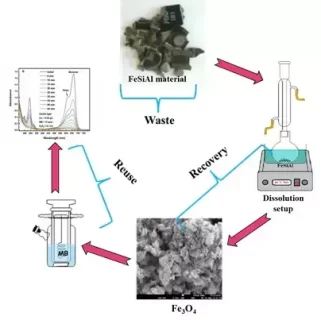Fe3O4 Nanoparticles from FeSiAl Alloy of Spent Printed Circuit Boards and its Application in Dye Degradation
Authors
- Dinesh Patil 1
- M. B. Sridhara * 2
-
J. Manjanna
 3
3
- Sandip Sabale 4
Abstract
Fe is an important element, used in soft magnetic materials (cores) in electrical and electronic devices and its concentration in e-waste is high. Thus, this study is aimed to recover Fe from the soft magnetic FeSiAl cores of spent printed circuit boards (PCBs). Here, the Fe-rich FeSiAl cores were identified, separated manually, and subjected to dissolution in citric acid (100 mM) and ascorbic acid (10 mM) mixture at 80 °C. The dissolved Fe was selectively precipitated as Fe3O4 using 20% NaOH in an N2 atmosphere at 90 °C for about 60 min. The obtained Fe3O4 shows ferromagnetic behavior with 30 emu/g saturation magnetization at 300 K. The BET surface area of Fe3O4 NPs was found to be 71.656 m2 g–1. Furthermore, the Fe3O4 NPs were utilized for methylene blue degradation with H2O2 in visible light irradiation. At optimum conditions, such as 10 ppm MB solution, 0.1 mL H2O2, and an S:L ratio of 0.05 g/L about 100% degradation was achieved in about 45 min under visible light irradiation and the correlated rate constant is 0.084 min-1. We believe that the synthesis of value-added compounds directly from the dissolution medium is an environmentally benign step toward resource recycling.
Highlights
- Soft magnetic FeSiAl cores were separated manually and subjected for dissolution.
- Complete dissolution of FeSiAl was achieved using CA: AA in about 240 min.
- The dissolved Fe was selectively recovered as Fe3O4.
- Visible-light-driven complete degradation of MB dye in about 45 min.




